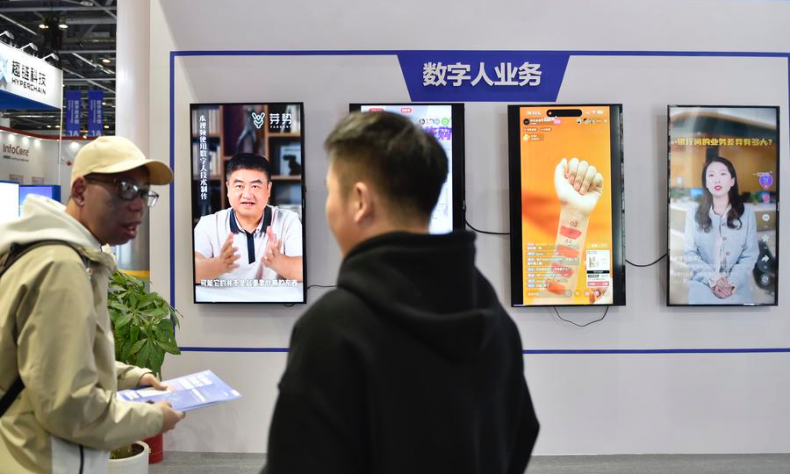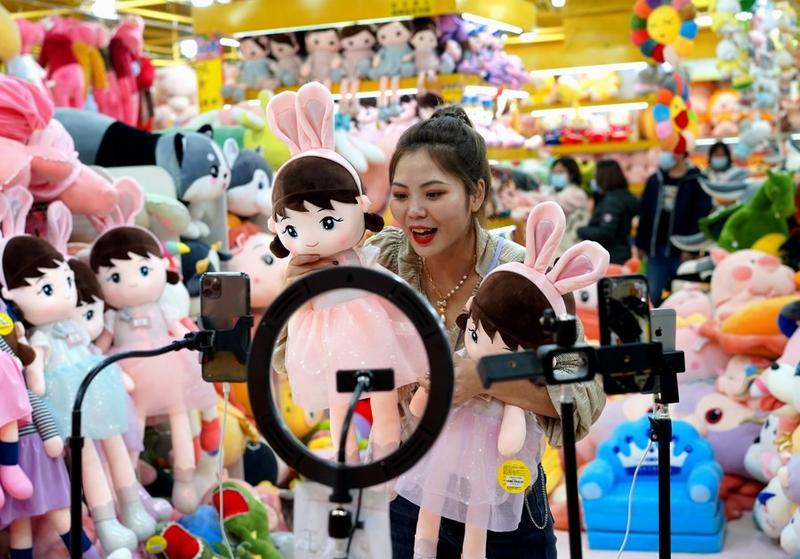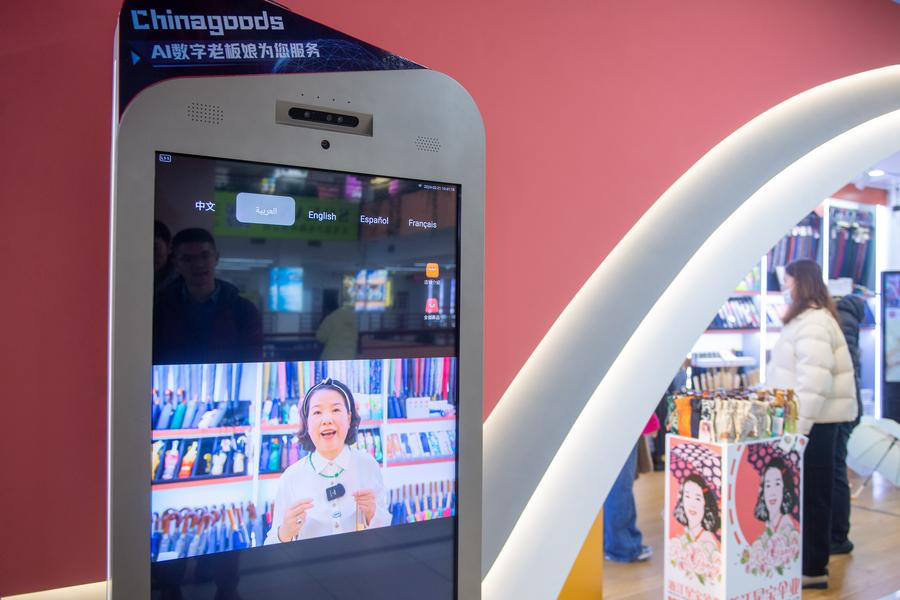AI Livestreamers Are Reshaping the Retail Industry

It is projected that by 2028, AI will realize full chain ‘decision-making automation’ across the retail industry. The adoption rate of AI throughout the entire process—from product selection and design to marketing—will surpass 70 percent, marking human-machine collaboration as the new norm in retail.
During a livestream, a host is busy presenting products, engaging with viewers and figuring out their shopping preferences.
“This toner not only provides hydration but also delivers essential nutrients to the skin.”
“Are you interested in our facial cream? Please let me know your skin type and the desired effects.”
“Is this product intended for personal use or as a gift? We offer a variety of product combinations and tailored discount options that may suit your needs.”
The host is not a real human but an AI-powered digital assistant—nearly indistinguishable from real, human streamers. Whenever consumers enter the livestream room, they will always see the friendly face and hear professional explanations.
Powered by pixels
In China, a pioneer of digital livestreamers is a tech company called Johnsmith.ai. According to its CEO Li Shizun, digital livestreamers have been deployed by his company since 2022, and within three years, the cumulative “working” hours of the digital livestreamers developed by the company have exceeded 3 million. Working such long hours would be unthinkable for “human” livestreamers.
Data provided by Johnsmith.ai show that, over the past three years, it has helped its over 530 customers sell 5.1 billion yuan ($711 million) of merchandise in total.
Taobao and JD.com are the two major Chinese e-commerce platforms that have cooperated with Johnsmith.ai. Its clients span a variety of consumer goods categories, including personal care and beauty, apparel and accessories, maternity and baby products, household appliances, and daily necessities and jewelry. Among them are notable international companies like L’Oréal, Estée Lauder, Procter & Gamble and Nestlé, as well as luxury goods groups like LVMH.
But why do so many domestic and foreign large groups opt for AI-generated livestreamers? Li provided a simple answer: reduce costs and increase efficiency.
Today, livestream e-commerce, or live-commerce, mainly features two models: influencer-led streaming and merchant-led streaming. The former leverages the influencers’ existing fan base, utilizing their personal traffic to drive sales. Although this model can rapidly boost popularity and sales performance, most top-tier influencers charge high commission fees. However, if the livestream is conducted independently by merchants, the hosts may lack experience, resulting in a suboptimal performance. Moreover, the expenses and time costs involved in training livestreamers lead to low sales efficiency and low return on investment rates.

The emergence of digital hosts has effectively addressed this issue. A well-developed and mature digital livestreaming team can offer merchants end-to-end services. “Merchants simply need to provide brand and product information, and the team handles everything—from creating hosts to building a fully interactive virtual livestream room. This eliminates the need for hiring and training human hosts, as well as building or renting venues,” Li told Beijing Review, adding that 24/7 broadcasting is one of the most direct advantages of digital livestreamers.
According to the data, AI-powered virtual livestream hosts help brands improve efficiency by driving incremental gains even during late-night hours, while filling the gap left by human streamers. This boosts conversion rates during off-peak hours and accelerates overall sales performance. For mid- to long-tail companies, the advantage is even more pronounced.
“At the beginning, beauty brand Helena Rubinstein, which began cooperating with Johnsmith.ai in April 2022, used digital livestreamers only during late-night hours. However, the clear advantages and results soon convinced them to extend the service into the prime morning time slots. They not only renewed their contract but also expanded the scope of collaboration and purchased additional AI livestream rooms on another e-commerce platform,” Li elaborated.
“At the same time, our contract renewal rate exceeds 90 percent, which speaks to the strong recognition from brands and highlights the vast potential of digital livestreamers,” Li added. “It is because another standout advantage of digital livestreaming is its ability to create fully customized host avatars and livestream room styles tailored to a brand’s specific tone and identity. This level of personalized customization generates a more accurate and targeted response to client needs.”
Building on an already remarkable track record, the company recently launched a new generation of digital double—the real-time avatar, featuring a comprehensive upgrade of previous functionalities. This means the avatar can now perform at the level of a top-tier livestreaming host, and more.
A bigger stage
“In the early stages, we prioritized developing the voice and appearance of our virtual hosts. Over time, we pushed both aspects to a level of high verisimilitude. And moving forward, we believe it’s time to focus our efforts on achieving greater smoothness and enhancing their performance in product promotion,” Li said.

Now, the digital hosts can move like real people, thanks to the company’s self-developed AI computer vision engine. The generation efficiency and mobility of digital livestream hosts have been largely improved. Virtual hosts can naturally perform complex actions such as trying on products, covering the mouth, turning their heads and presenting items. “Now, real-time avatars can start broadcasting as soon as new products are launched, and can easily support the daily update of over 100 products,” Li said. Plus, by introducing audio-video synchronization technologies, the company enables the digital hosts to achieve more precise coordination in speaking, facial expressions, movements, close-ups and the overall pace of product presentation.
In terms of interaction with consumers, Johnsmith.ai integrates multi-modal large models with a multi-agent architecture, so that digital livestreamers are able to respond to customer needs almost simultaneously.
However, Li admitted that avatars cannot replace top-tier human livestreamers, even though they already possess corresponding capabilities. “Top streamers have their own fan base comprised of very loyal customers, and some of whom pay for the personal charm of the streamer,” he said.
“And, sometimes, digital livestreamers may appear untrustworthy to certain audiences due to their perceived ‘perfection,’ such as the absence of common human traits like hesitation, stuttering or verbal slips, which are typically associated with authenticity,” he continued.
In Li’s opinion, livestreaming aside, AI has already become indispensable in scenarios such as supply chain forecasting, where error rates have dropped to 8 percent, and virtual try-ons, which have led to a 35-percent reduction in product return rates.
“It is projected that by 2028, AI will realize full chain ‘decision-making automation’ across the retail industry. The adoption rate of AI throughout the entire process—from product selection and design to marketing—will surpass 70 percent, marking human-machine collaboration as the new norm in retail,” he concluded.
 Facebook
Facebook
 Twitter
Twitter
 Linkedin
Linkedin
 Google +
Google +










